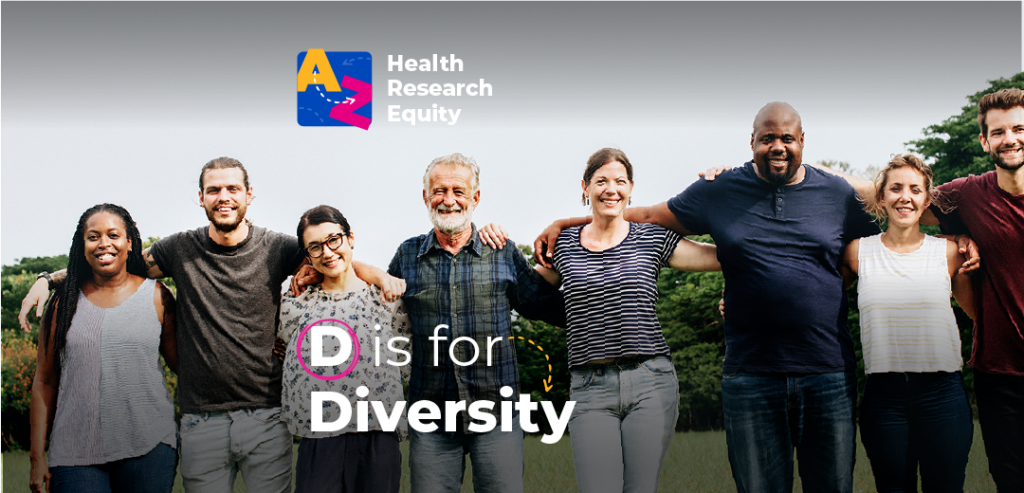We’re speeding through our fortnightly A–Z of Health Research Equity series. In this instalment, we’re talking about what is likely the most obvious candidate for the letter D. I had a list of options that included Data and Demographics, and when I asked a few of my COUCH colleagues which option they thought I should go for, they tactfully replied with something along the lines of ‘They sound good, but Diversity might also be something to think about’.
So here we are, with the thing that underpins our entire existence as a business: D is for Diversity (and potentially ‘D’oh!’ in my case, but we’ll chalk that up to overthinking it…). If this is the first post you’re reading in this series, I’d recommend catching up with the beginning of the series here.
Why has diversity become a focus in recent years?
Diversity has become a key area of discussion in various industries in recent years, but health and health research have perhaps been in the spotlight more than others. For some the push for diversity came as a surprise, a sudden jolt that what they had been doing for years wasn’t having the same impact on everyone. For others, it was a time of mixed emotions; thankful that people were finally listening and gutted that such tragedy had sparked these conversations.
The murder of a 46-year-old Black American man, George Floyd, at the hands of a white police officer in Minneapolis, Minnesota, on May 25th, 2020, sparked protests not only across the US but around the world. Against the backdrop of stark inequities highlighted during the COVID-19 pandemic, protests against police brutality led to a wider push for equity and a call for change.

It was a perfectly unjust storm that demonstrated what many of us already knew: the world remains riddled with unjust and avoidable differences.
Since 2020, the call for equitable and fair access to healthcare and treatment has (finally!) transformed from a few of us shouting into what felt like the abyss, to a loud roar that won’t be silenced. Still, I’m conscious that shouting or roaring doesn’t always lead to results, so at COUCH, we are pushing for impact and genuine, practical change for patients.
Diversity for the sake of diversity?
For many of us working in this space, diversity and inclusion in research is a moral and ethical necessity. It’s the right thing to do. That said, diversity for the sake of diversity will not change the status quo.
To make change, we need something to hold onto; a tangible target, an ambition to aim for, a metric to meet. In health research, that means understanding the clinical area we are working within and which groups are at greater risk of becoming unwell and less likely to receive the care they need. Those are the people we need to prioritise when it comes to research engagement and participation.
For example:
- Clinical area: Maternal mental health
- Who is at greater risk? Women and birthing people who are Black and brown, under the age of 20, and/or experiencing multiple disadvantages such as domestic abuse, poverty, insecure housing, and addiction (insights from the UK’s Maternal Mental Health Alliance).
The question of who is at greater risk of becoming unwell and less likely to receive support may seem simple. But, these data do not always exist, particularly regarding rare diseases. In that case, we can look to broad information on who is under-served by health research.
Who is under-served by health research?
In 2017, the UK’s National Institute for Health Research commissioned the INCLUDE project (Innovations in Clinical Trial Design and Delivery for the Under-served) to address the lack of representation in health and care research. The first step was to understand who is not effectively included in health research; the list may shock you.
I often use the text below in presentations, intentionally filling the slide with text to highlight the overwhelming nature of the problem.
Health research works for you if you are:
*Deep breath*
A financially stable (but not in full-time employment), well-educated, middle class, digitally literate, city-living in standard accommodation, neurotypical, not part of a religious minority, not pregnant, not disabled, non-smoking, cisgender, heterosexual, fluent English-speaking, white (but not from a white minority), man, between the ages of 18 and 75, with no experience of mental illness, learning disabilities, addiction, or cognitive, visual, or hearing impairments, but who does attend regular medical appointments, and is of a ‘healthy’ weight.
I’d put money on you not being that person; it’s certainly not me. The reality is that most health research includes a narrow set of patients that fit the characteristics above; the rest of us will encounter health inequities as a result.
Prioritising diversity in our work is not a ‘hot’ topic or a box to tick; it’s a way to rebalance society’s inequalities and improve – and save – the lives of patients.









